Hybrid Topology
Hybrid Topology

Advantages
There are many reasons why hybrid topologies are used but they all have one thing in common: flexibility. There are few constraints on the structure that a hybrid topology cannot accommodate, and you can incorporate ring, bus, mesh, and star topologies into one hybrid setup. As a consequence, hybrid topologies are very scalable. Their scalability makes them well-suited to larger networks.
Disadvantages
Unfortunately, hybrid topologies can be quite complex, depending on the topologies that you decide to use. Each topology that is part of your hybrid topology will have to be managed according to its unique requirements. This makes administrators’ jobs more difficult because they are going to have to attempt to manage multiple topologies rather than a single one. In addition, setting up a hybrid topology can end up being quite costly.
No comments:
Post a Comment